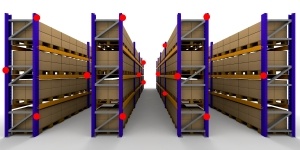Summer is finally here, and temperature mapping season as well. Let’s get mapping!
Customers perform temperature mapping to generate the temperature profile of a facility. This helps manufacturers, distributors and transporters of temperature sensitive products protect their value by identifying potential environmental control problems before it affects the product.
Inadequately controlled environments can lead to ineffective products or product loss. Both Health Canada and the FDA require temperature mapping to comply with their regulations.
“Monitoring of storage facilities is conducted at points representing the worst case scenarios of the temperature range based on temperature mapping.” - Guidelines for Temperature Control of Drug Products during Storage and Transportation, GUI-0069 Health Canada
The first step to perform temperature mapping is to write the protocol, a document that will guide you throughout the study.
This document should include the 5 following sections:
1- Choose the Perfect Moment for Temperature Mapping
Worst Case Scenarios: You should perform temperature mapping in all storage areas during the coldest week of winter and the warmest week of summer. This increases the probability that such storage areas will remain within temperature limits at all times throughout the year.
Prior to Moving/Opening a New Facility: We strongly recommend to map the storage area when empty, although not always practical. Nevertheless, when a customer moves or opens a new facility it is beneficial to conduct temperature mapping before loading the storage area, then repeat once the products are there.
You should repeat your temperature mapping every 3-4 years. The mapping should also be re-done if there has been significant modification to the premises, stock layout, or heating system.
Quick tip: You don't need to specify the exact timing during the protocol writing step. However, you do need to specify the season.
2- Determine Data Logger Distribution
There is no set formula for the number or placement of data loggers that should be used for a mapping study. However, your study must demonstrate 3-dimensional uniformity and compliance with your product requirements. Using a 3-dimensional temperature profile means installing data loggers on at least three planes - top to bottom, left to right and front to back.
Alternatively, install them in 3 heights (approximately at 6 feet, 12 feet and 18 feet), where high racking exists. Whichever option you select, make sure to use a consistent rationale for data logger distribution.
Add data loggers where known cool or warm areas exist and in all potentially problematic and critical locations. Such areas might include loading docks, solar heating from windows, near HVAC units, and where there is uneven building insulation.
Quick tip: Be sure to document the location of every data logger during protocol writing and label them to facilitate protocol execution.
3- Study Duration
The total duration of the temperature mapping study must capture enough data from the system's operations to justify consistent and repeatable operation. The study must also capture events considered "worst case" scenarios of the temperature range.
For an empty warehouse, perform your mapping study over a 3-day (72 hours) period.
For an operating warehouse, extend the mapping period between 1 to 2 weeks (between 7 and 14 days). This will allow to capture variations in the schedule that may impact air flow, resulting in temperature fluctuations.
4- Temperature Range
Store all pharmaceutical products and materials according to the conditions described on their label. During the temperature distribution verification, verify the temperature acceptance limits on the label specification to prove that the storage conditions reflect the labeling specifications.
If you have various storage conditions, you must test the smallest temperature range.
5- Tests
Always follow the procedures in your protocol to perform the temperature distribution test. It identifies the steps that you have to follow to perform and document the study. This test will analyze the temperature distribution inside the warehouse.
Always have trained and experienced technical personnel conduct the temperature distribution verification. Document in a scientific manner and use an established format.
Once these essentials are taken into account, you can then proceed to protocol execution.
Don't want to handle protocol writing yourself? Click here to ask one of our regulatory compliance experts how we can help!





